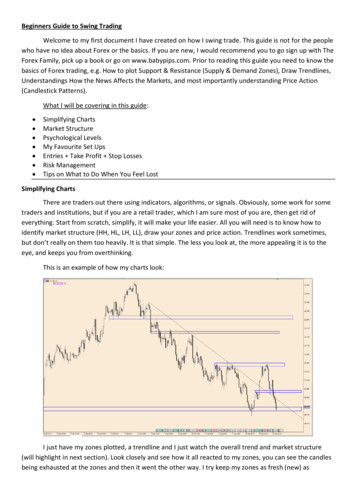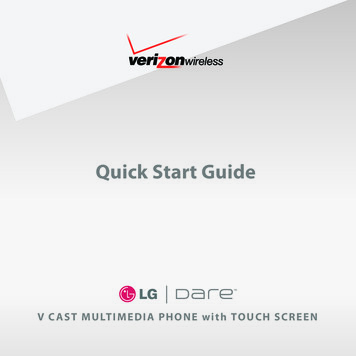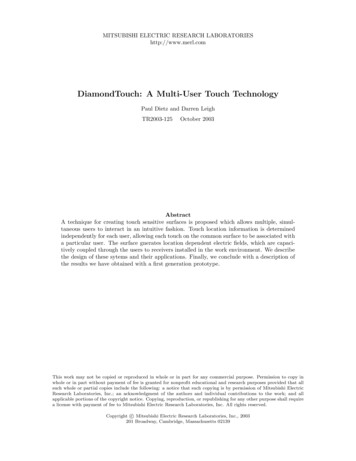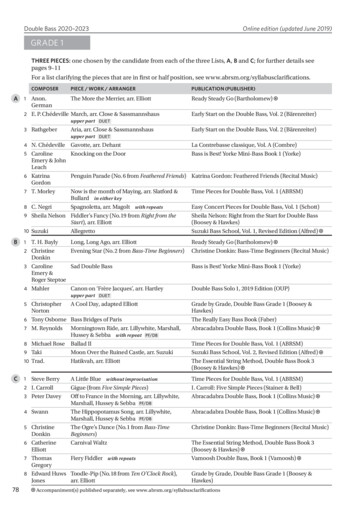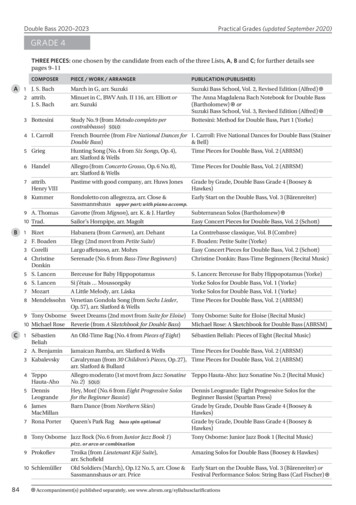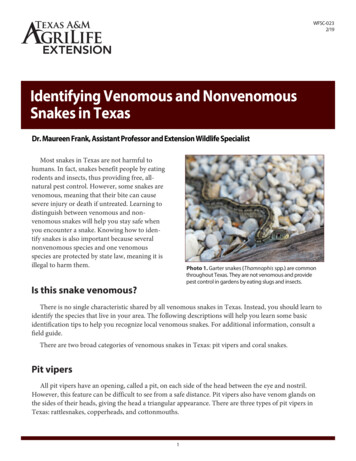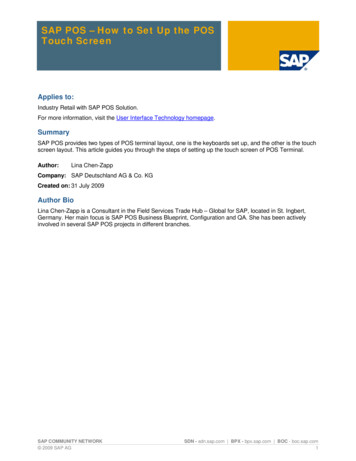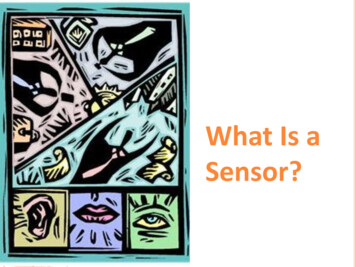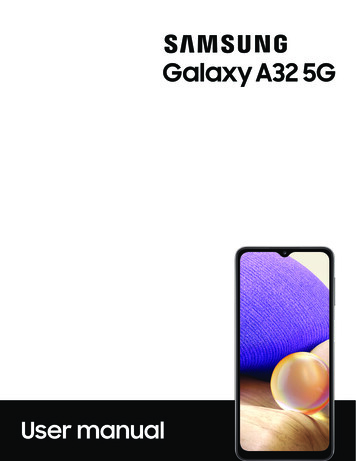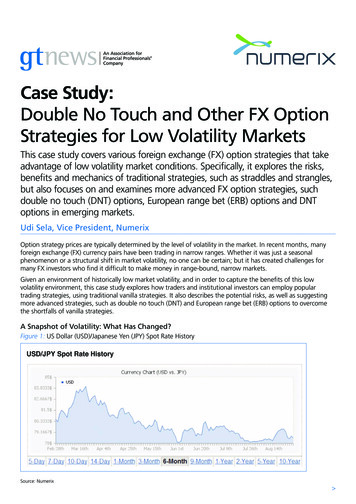
Transcription
Case Study:Double No Touch and Other FX OptionStrategies for Low Volatility MarketsThis case study covers various foreign exchange (FX) option strategies that takeadvantage of low volatility market conditions. Specifically, it explores the risks,benefits and mechanics of traditional strategies, such as straddles and strangles,but also focuses on and examines more advanced FX option strategies, suchdouble no touch (DNT) options, European range bet (ERB) options and DNToptions in emerging markets.Udi Sela, Vice President, NumerixOption strategy prices are typically determined by the level of volatility in the market. In recent months, manyforeign exchange (FX) currency pairs have been trading in narrow ranges. Whether it was just a seasonalphenomenon or a structural shift in market volatility, no one can be certain; but it has created challenges formany FX investors who find it difficult to make money in range-bound, narrow markets.Given an environment of historically low market volatility, and in order to capture the benefits of this lowvolatility environment, this case study explores how traders and institutional investors can employ populartrading strategies, using traditional vanilla strategies. It also describes the potential risks, as well as suggestingmore advanced strategies, such as double no touch (DNT) and European range bet (ERB) options to overcomethe shortfalls of vanilla strategies.A Snapshot of Volatility: What Has Changed?Figure 1: US Dollar (USD)/Japanese Yen (JPY) Spot Rate HistorySource: Numerix
When we look at volatility levels approximately one year ago, we can observe that three-month implied volatilitytraded around 11%, with spot three-month historical volatility trading around 9.5%.As of mid-August 2012 we saw a significant change, with three-month implied volatility trading around 7.5%,and the spot three-month historical volatility trading around 6.4%. It is important to note that these representthe lowest volatility levels in the past five years.Case Study Examples: FX Options for Low Volatility MarketsIn the case study examples that follow, we will uncover the best strategies for taking advantage of these typesof low volatility environments, examining the benefits, risks and mechanics of each option type. As far as ourunderlying currency choice, we have selected to use a US dollar (USD)/Japanese yen (JPY) case study, given thatJPY is perceived as a ‘safe haven’ currency, and because the Bank of Japan (BoJ) is supporting the USD below76.50 and thereby creating a floor for the dollar.Exhibit I: Selling Volatility Using Traditional Strategies (USD/JPY)First, we will take a closer look at the more traditional vanilla strategies, beginning with selling a straddle. Inthis scenario, we sell a straddle, consisting of two options: USD call plus USD put USD/JPY; with both struck atthe money (zero delta straddles); US 10m per leg and expiry in three months. The premium received would beUS 293,000.Risk analysis for selling a straddle (USD/JPY)The potential risks involved in this strategy include: limited profit (premium), with potentially unlimited loss;mark-to-market losses; and short gamma, which means expensive hedging for those choosing to hedge(typically sell-side players) (see Figure 2).Figure 2: Risk of Selling a Straddle (USD/JPY)Source: NumerixWe can also observe the following risks: increased loss as the spot rate moves significantly in either direction;short gamma mostly across the strike prices; and short Vega. We would also need to take a look at the timehorizon, and determine the risk features of the strategy over time.
Figure 3: Sell Volatility: Selling USD/JPY StrangleSource: NumerixExhibit II: Sell Volatility - Selling USD/JPY StrangleHere we will take a closer look at a second vanilla strategy: selling a strangle. In this scenario, we sell a strangle,consisting of a USD put struck at 76 and a USD call struck at 81; with US 10m per leg and expiry in threemonths. The premium received would be US 95,500.Risk analysis for selling a strangle (USD/JPY)The potential risks involved in this strategy include: limited profit (premium) with potentially unlimited loss;mark-to-market losses; short gamma, which again means expensive hedging (when performing dynamichedging), and short vega. We can observe lower risk as opposed to the earlier straddle, since strike prices arefurther out of the money. As a result, the premium received for this strategy would not surprisingly be lowerthan the straddle.Figure 4: Risk of Selling a Strangle (USD/JPY)Source: NumerixWe can also observe risks such as increased loss, as the spot rate moves significantly in either direction; short gammamostly across the strike prices; and short vega. We would also need to take a look at the time horizon again.
Figure 5: Time Horizon of Selling a Strangle (USD/JPY)Source: NumerixExhibit III: A Comparative Analysis: Straddle/Strangle (USD/JPY)Table 1: A Comparative Analysis: Straddle/Strangle (USD/JPY)Source: NumerixAdvanced FX Option Trading Strategies for Low Volatility MarketsExhibit IV: Sell Volatility (USD/JPY) - Buy a DNT OptionHere we will take a closer look at some of the more advanced FX option strategies that can be advantageousin low volatility markets, including first the DNT option. We will explore the mechanics of DNT strategies andexplain how they can help investors seeking higher returns, while limiting potential losses.In this case study example, we receive US 1m if the market doesn’t trade on any day up until expiry, at 76.50or below - or at 81 and above. This sample option has a three-month expiry, with premium to be paid ofUS 230,000 (upon inception date).Risk analysis for buying a DNT option (USD/JPY)The potential risks and benefits to this strategy include limited loss (premium); potential profit of US 1m (fourtimes over premium paid); but also potential mark-to-market losses. In addition, the premium must be paid inadvance (upon inception date).If toward expiry, the spot rate trades near the triggers, then the delta and gamma become very high. Here, wecan also observe that vega diminishes over time.
Figure 6: Risk of Buying a DNT Option (USD/JPY)Source: NumerixFigure 7: Snapshot: USD/JPY DNT Delta DifferencesSource: NumerixFigure 8: Snapshot: USD/JPY DNT Gamma DifferencesSource: Numerix
Figure 9: Snapshot: USD/JPY DNT Vega DifferencesSource: NumerixExhibit V: Sell Volatility - USD/JPY ERB OptionIn this scenario, we buy an ERB option. We would receive US 1m only if at expiry the market doesn’t trade at 76.50 orbelow, or trade at 81 and above. The option would have a three-month expiry with premium to be paid of US 558,000.With this option, we would experience limited loss (premium) and a potential profit of US 1m (almost twiceover premium paid). Potential mark-to-market losses would be possible. The premium would need to be paidin advance (upon inception date) for this option. It is important to note that there is a lower probability of therange being breached than with the DNT option, hence the lower potential profit than the DNT.Risk analysis for USD/JPY ERB optionWe can observe that the ERB’s risk profile is very similar to the DNT’s risk profile. However, if towards expiry thespot rate trades near the triggers, delta and gamma increase to extreme levels (well above DNT), due to theadditional leverage effect.Figure 10: Risk of USD/JPY European Range Bet OptionSource: NumerixExhibit VI: DNT Options in Emerging Markets: USD/ZARIn this last case study example, we have chosen South African rand (ZAR) as the underlying currency because itis highly volatile and exhibits high negative correlation with the euro (around -0.7).If we buy a USD/ZAR DNT, we would receive US 1m if the market doesn’t trade on any day until expiry at 7.95or below, or 8.95 and above. The option would have a three-month expiry with premium to be paid in theamount of US 230,000.
When buying a DNT option in an emerging market (in this case USD/ZAR), we can observe limited loss(premium); a better leverage ratio or set a wider range between the two triggers; and we can gain a potentialprofit of US 1m (four times over premium paid). We would experience potential mark-to-market losses; and thepremium would need to be paid in advance (upon inception date).Risk analysis for USD/ZAR DNT optionAs the option has a high time value, we should highlight what is happening to the theta in the chart below. Inaddition, as the volatility of the currency pair is much higher, the risk of hitting the barriers is higher as well. Wewould experience a better risk reward/ratio, but clearly there is a lower probability of a payoff at expiry.Figure 11: Risk of USD/ZAR DNT OptionSource: NumerixThe unprecedented levels of volatility experienced over the past two years, coupled with the high level ofuncertainty, have been drivers for adopting a prudent approach to managing FX exposures. When decidingand implementing a hedging programme one must take into account the historical and projected underlyingprices fluctuations, examine and select the most suitable hedging strategies, as well as running the selectedprogramme through various potential market scenarios and determine its efficiency. Decision support systems toassist with managing the hedging process are readily available.Figure 12: Summary: A Comparative Glance at MTM Three Weeks LaterSource: NumerixConclusionThe environment over the summer months and early autumn in northern regions has been characterised bylow volatility, leaving many FX investors with the desire to look beyond traditional FX option strategies to takeadvantage of this environment.This has led us to a deeper exploration and comparison of the various trading techniques available for today’s FXmarket practitioners looking to benefit from expected low volatility. Clearly, we can see that traditional strategiesoften entail unlimited risk in cases of sudden ‘violent’ moves (as it’s always the case when selling options). Wecan also observe that buying DNT options can limit the potential loss to the premium paid, which can be more
desirable for many investors, who may shy away from the concept of ‘unlimited risk’.At the same time, DNT and ERB options can provide increased profit potential, as compared with more traditionalvanilla strategies. In this study, we have also seen how the implied volatility of the underlying asset determines therisk/reward profile. Ultimately, we realise that it’s important to carefully examine the benefits, risks and mechanicsof each option type, to determine the best investing strategy and risk profile for your business.Udi Sela, vice president at Numerix, has worked in the foreign exchange (FX) derivativesmarkets for 18 years. A senior derivatives trader and trading manager at Citibank andJP Morgan, he has developed expertise in derivatives spanning both vanilla and complexFX options. During the last seven years, Sela has led product development and pre-salesfunctions within a range of financial software vendors. He holds an MBA in Finance andTechnology Management.Numerix is the award winning, leading independent analytics institution providing cross-asset solutions forstructuring, pre-trade price discovery, trade capture, valuation and portfolio management of derivatives andstructured products. Numerix offers client a highly flexible and fully transparent framework for the pricingand risk analysis of any type of over-the-counter (OTC) derivative financial instrument. Since its inceptionin 1996, over 700 clients and 80 partners across more than 25 countries have come to rely on Numerixanalytics for speed and accuracy in valuing and managing the most sophisticated financial instruments.With offices in New York, London, Paris, Frankfurt, Milan, Stockholm, Tokyo, Hong Kong, Singapore, Dubai,South Korea, India and Australia, Numerix brings together unparalleled expertise across all asset classes andengineering se Study Double No Touch and Other FX Option Strategies for Low Volatility Markets.html
Advanced FX Option Trading Strategies for Low Volatility Markets Exhibit IV: Sell Volatility (USD/JPY) - Buy a DNT Option Here we will take a closer look at some of the more advanced FX option strategies that can be advantageous in low volatility markets, including first the DNT option. We will exp

